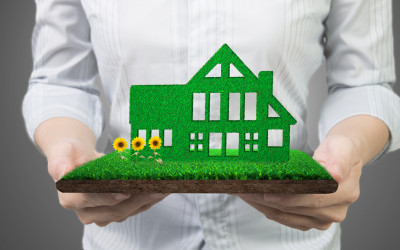Green homes are on the rise. Why?
In 2019, the average electric bill in the United States was $115 a month. Green homes are typically 20% to 30% cheaper in electric costs and can be built at the same price as a traditional home. They can also qualify for insurance discounts or tax breaks.
The difference in environmental impact is huge. In the United States, buildings are responsible for:
- 38% of carbon dioxide emissions
- 39% of total energy use
- 74% of total electricity use
Green housing reduces waste, conserves natural resources, and protects ecosystems. It also creates healthier living spaces and improves air and water quality.
How do you reap these benefits for your newly constructed home? Follow the trends other green homeowners have set.
Whether you are building or buying a home, these 13 green home trends will narrow your choices for a healthy, environmentally conscious home.
13 Green Home Trends for Home Buyers
Due to their many benefits, green homes have become popular over the years. Homeowners who are into green housing also practice several trends in home building, including the ones below. Keep them in mind when you browse new homes for sale or hire custom home builders.
1. Prefabricated Homes
Prefabs are precision-engineered, pre-built homes that are shipped and assembled on a lot. These have become popular due to their affordability, durability, and construction speed.
No more waiting for your house to be finished – just put the pieces together and move in. Constructing prefabs produces far less waste than traditional construction sites. That’s good for you and the environment.
2. Cargotecture
This term refers to homes built entirely from recycled shipping containers. Shipping container materials are considered high-quality waste, which can quickly overburden landfills.
Cargotecture homes are attractive due to their durability, security, sustainable design, and inexpensive construction. Some can even be relocated.
3. Urban Infill Construction
Some people rebuild rundown structures in cities into homes. This method utilizes existing buildings, thereby reducing urban sprawl and protecting green space.
An economic benefit to urban infill construction is the increase in houses within the city limit. This is a great option for environmentally conscious homebuyers.
4. Tiny Homes
Minimalists love tiny homes. With an average of 186 square feet, these small living spaces are more efficient, earth-friendly, and mobile than other homes. Due to their efficiency, they have little to no monthly costs, making them more affordable.
As a bonus, their small space is also easier to clean.
5. Passive Homes
Passive homes, or “Passivhaus,” are popular because they minimize heating demand by optimizing thermal performance and airtightness.
These houses can be up to 90% more efficient than standard homes – something to keep in mind when building your next house.
6. Smart Homes
Many homeowners go eco-friendly with technology. Smart home automation usually controls temperature, security, and lighting.
NuBryte, a leading smart home technology, has additional features, including:
- Built-in intercom
- Home hub organizer
- Energy monitoring
- Timers
- Individual room temperature regulation
Smart technology like these can make a green home infinitely easier to manage.
7. Efficiency Technology
What do you think of when you hear “green”? Solar panels?
Those are common technologies, but there are others such as water reclamation, reflective roofs, LED lights, and energy-saving appliances. Cool roofs, which include low, steep-sloped, and green roofs, are particularly efficient. Efficiency is important for equipment that is operated continuously.
8. Green Certification
To meet the rising demand for green standards, home builders have integrated green certification into their building practices. Leadership in Energy and Environmental Design (LEED) is the leading standard for green construction in new homes.
LEED-certified homes are resource-efficient and therefore less costly for you and the environment. Other green certifications include the WELL Building Standard and the Living Building Challenge.
9. Water Conservation
With the rising concern over the global and national fresh water supply, people have taken measures to conserve water. These include:
- Managing stormwater
- Catching rainwater
- Recovering graywater
- Investing in green roofs
In addition to the above, you can install water-conserving appliances such as low-flow toilets and showerheads in your home. These reduce water use for a smaller environmental footprint and lower water bills.
10. Reclaiming and Recycling
“Reduce, reuse, recycle” is the mantra of most green homeowners trying to reduce waste.
You can use recycled materials for almost any part of your house, from tiling and decking to doors, insulation, roofs, and walls. Mass timber panels are popular, as this post-industrial waste wood preserves old-growth trees.
11. Large Windows
Another trend among homeowners is large windows. More natural light brings health and happiness indoors.
In a green home, large windows are statement glass with a purpose. With tighter seals and glazing to keep outside temperatures out, these windows bring beauty to the home without reducing energy efficiency.
12. Living Walls
Living walls are the epitome of going green. Their rise in popularity is partly due to the aesthetics of having plants growing into the house.
A living wall brings natural beauty indoors and adds some color to the home. Plants freshen the air and act as natural humidifiers, creating a relaxing environment conducive to creativity.
Start Your Own Green Home Trends
Following these green home trends is an effective way to be a green homeowner yourself. Keep them in mind when house hunting as well. If your goal is to save energy, resources, and be kinder to the environment, then remember this list of ways to achieve that goal.
Share this Post
